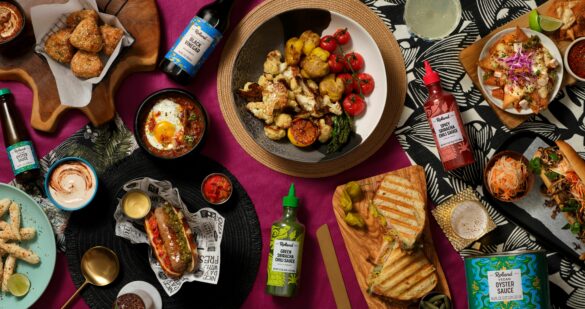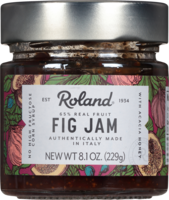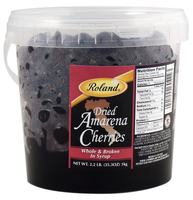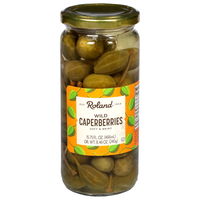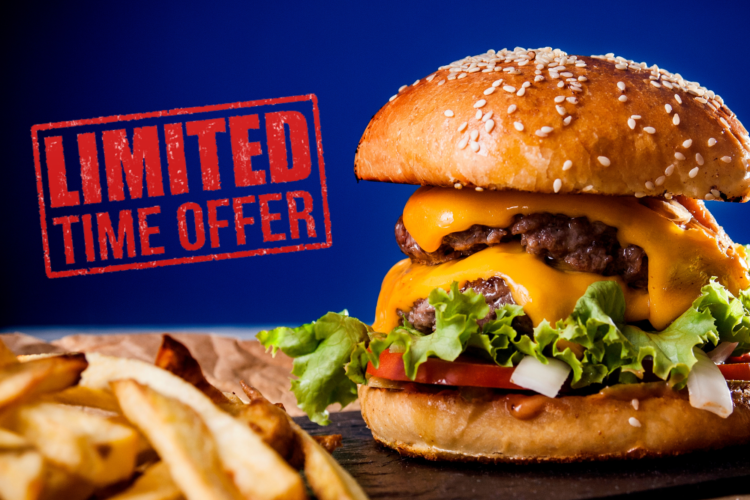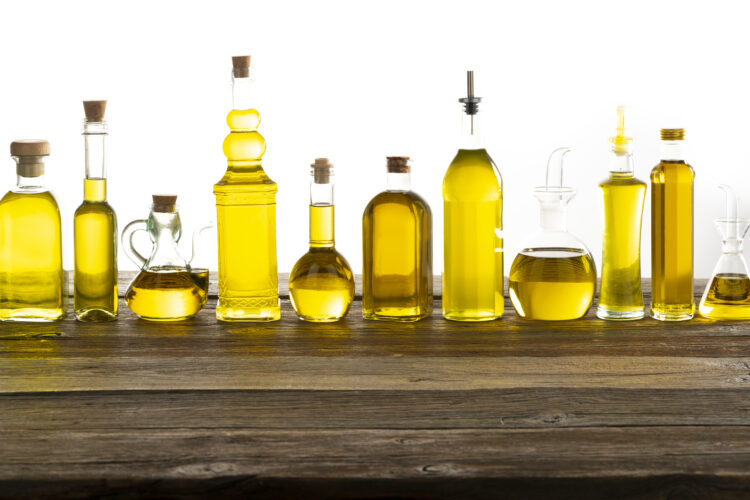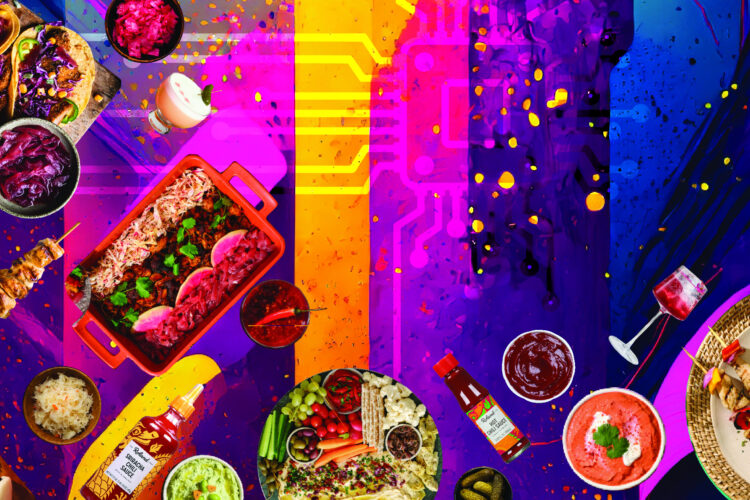March 27, 2023 | Food Trends Product Education
Raising the Bar: A Guide to Building a Successful Restaurant Beverage Program
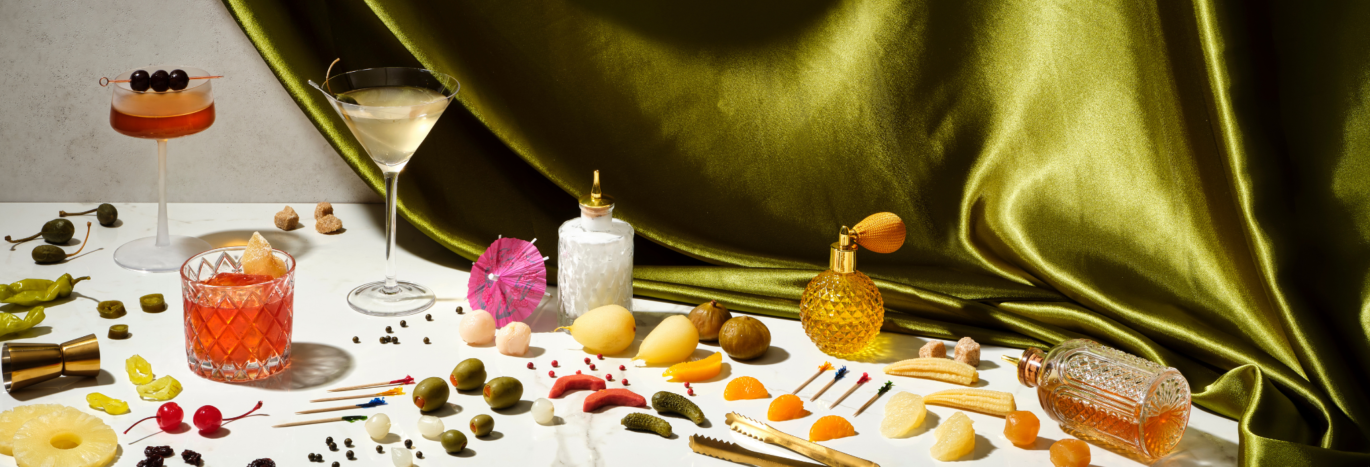
As discussed in our 2023 Fine Foods Industry Trends and Predictions Guide, the pandemic inspired people to become at-home bar masters, and now when consumers dine out, they're looking for even more sophisticated and interesting cocktails than what they make at home. How can your beverage program impress?
As drinkers’ palates have become more sophisticated and complex, their desire for a complementary experience has grown. People who venture out to enjoy premium cocktails want to do so in a matching environment. Enter the cocktail bar. Online searches for “cocktail bars” have soared over the past 5 years, especially post-pandemic. From swanky speakeasies to themed haunts, a focus on libations is sweeping the nation – especially in large metro areas where trends tend to incubate before taking off.
With this trend in mind, an attractive beverage program is a crucial component in driving consumer interest and sales in your establishment. In this blog, we’re breaking down the steps to building a successful restaurant beverage program, from the basics all the way to new and exciting cocktail recipes we’ve created to inspire your own bar menu. Read on for the complete guide.
Building Your Unique Beverage Program
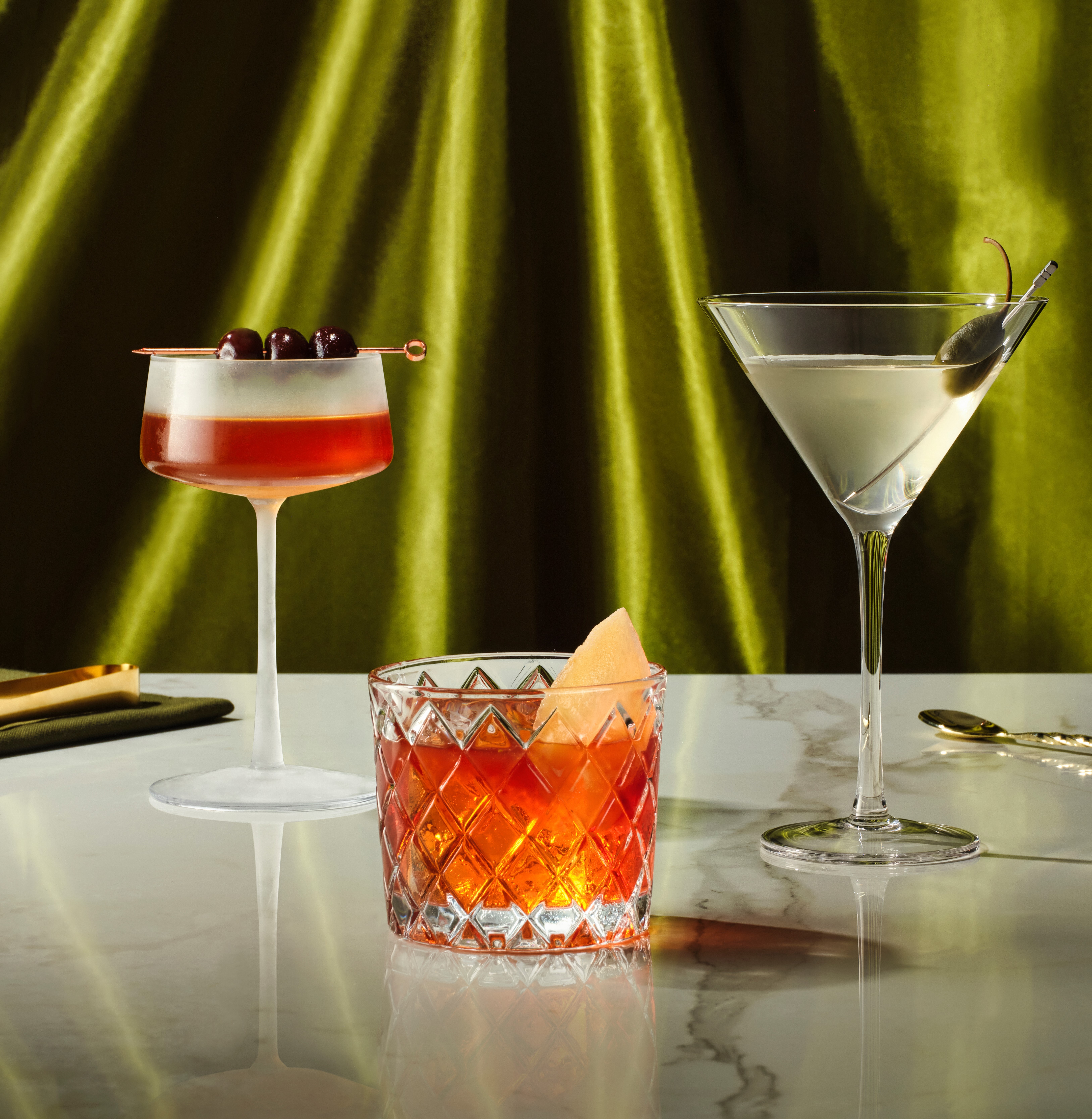
Developing a Concept
Identifying a bar concept sets the tone for your entire program and is the best place to begin. Consider the many factors that go into a beverage program: theme, design, lighting, and menu selections.
To Theme or Not to Theme?
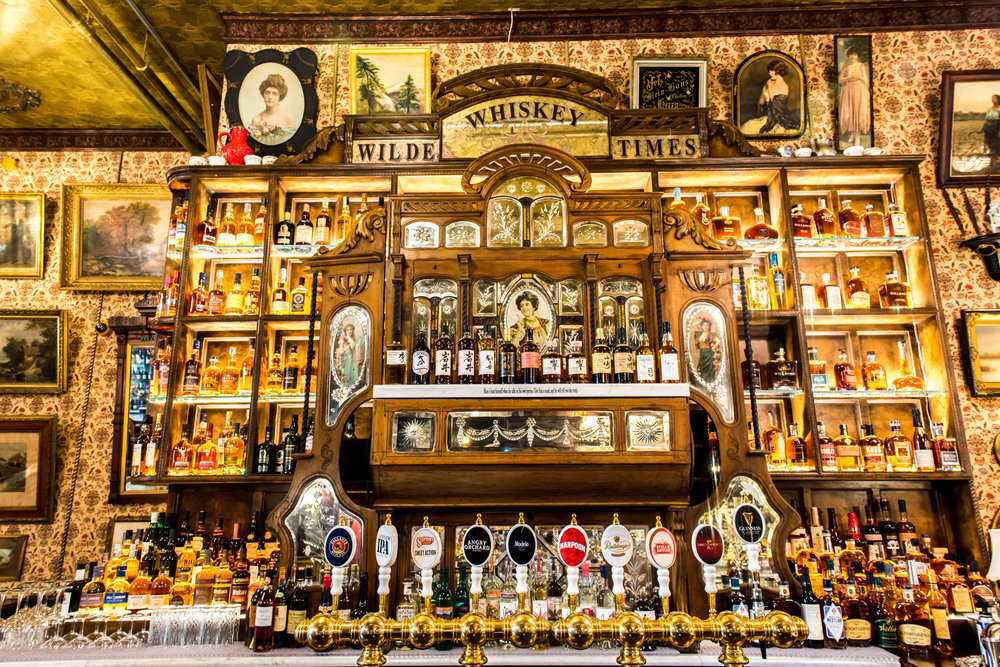
Themed bars and experiential dining are all the rage right now, as people continue to seek unique and one-of-a-kind experiences. Think outside the box – avoid using common concepts, like tiki bars, and try to think of something that hasn’t been done before! Consider sticking to a theme and running with it from start to finish – from the overall vibe of the bar to the names of your inventive cocktails.
Be creative but realistic. If you decide to give your bar a theme, the concept should be clear and resonate with your customers through the bar décor, names, and ingredients of the cocktails you offer. Choosing an abstract concept or theme may get lost, so you want it to be clearly conveyed to your customers as soon as they arrive.
Alternatively, if you decide against a theme and are leaning towards a more traditional bar experience, make sure your location’s ambiance and menu are top notch. Consider using unique ingredients and eye-catching cocktail presentations to inspire foot traffic and repeat customers.
Keep in mind: many factors impact a guest’s perception of a bar before they even sip their drink—think lighting, ambiance, music, seating, service and even aroma. All these elements should be taken into careful consideration before building your menu.
When building your beverage program, customers should not be your only consideration though. Head bartender at Compere Lapin, featured in Conde Nast for their outstanding cocktail program, Abigail Gullo, advises that when creating your concept, you must keep in mind the three major stakeholders: the owner, the staff, and the customers. Having a wholistic approach will allow you to analyze business needs from every angle, ensuring all parties are satisfied, resulting in skyrocketed sales.
Pricing for a Profit
Alcohol sales on average are more lucrative than food sales, therefore it is crucial to understand how to price your beverage menu to ensure you're bringing in the largest profit. Pour costs and ingredient prices will affect the overall cost of your beverages.
What is pour cost? It is the amount of money a drink costs a business. For example, if your beverage has a 20% pour cost, this means that every dollar of sales generated costs the business 20 cents. With that in mind, you want to keep your pour costs as low as possible to generate the most profit.
The industry standard for average pour cost is between 18-20%, with an average profit margin of around 78-80%. These averages will vary depending on location, venue, and beverage type.
Beer, wine, and spirits should have separate pricing strategies, as their profit margins and pour costs are different. Average pour cost by category:
- Wine - 28%
- Beer - 24%
- Spirits - 15%
A Balanced Bar Menu
Don’t forget to account for different alcoholic preferences. A recent study from Gallup observed that of drinkers in the United States, 35% prefer beer, 31% prefer wine, 30% favor liquor, with 3% having no preference. Offering a variety of cocktails, beer, wine and non-alcoholic or mocktail options ensures that all your guests will find something they enjoy.
Keep in mind your target audience and their age as studies show that alcohol preferences vary by age. Statista Global Consumers Survey concluded that cocktails are primarily ordered by consumers ages 21-39, beer from drinkers ages 40-59, and wine is most popular between ages 60-64.
Finding Flavors
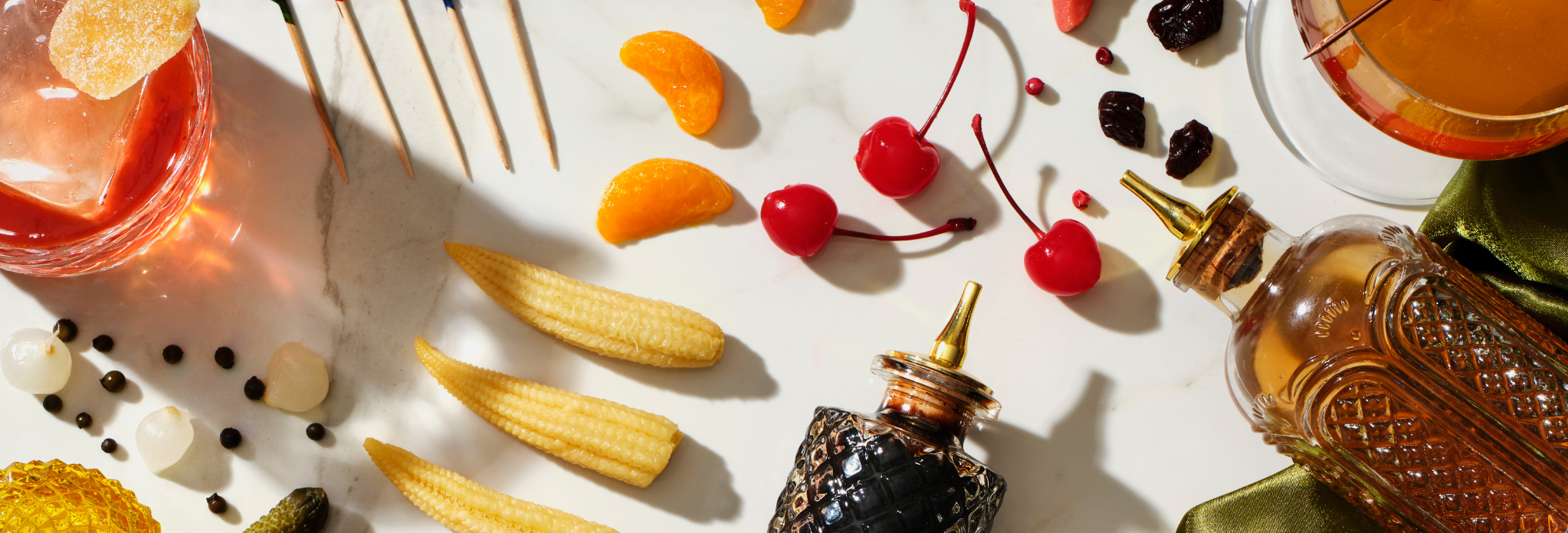
The selection of cocktails on a bar menu can make or break the menu’s success. When developing your beverage list, there are many things to consider.
- Remember your concept. The flavors of your cocktail should reflect your theme, as applicable. For example, a retro theme bar should incorporate cocktails, liquors, beers, and flavors that were popular in the years you are hoping to pay homage to.
- Separate yourself from your competitors. Having a unique selection of drinks or creating signature cocktails are great tactics to create a unique identity for your brand. Think about how you can incorporate interesting ingredients into each drink. Roland Foods has an entire Bar & Cocktail collection to consider if you are looking for inspiration!
- Maintain balance. Provide a selection of cocktails using a variety of spirits, with an equal amount of sweet and spirit-forward cocktails. Even consider expanding the flavor profiles to include spicy, savory, and umami drinks.
- Zero-proof it. Don’t forget about mocktails on your menu. These zero-proof drinks are popular, especially with Millennials and Gen Z drinkers, and create an inclusive menu for your guests who do not drink alcohol. A recent survey by Heineken 0.0 and OnePoll found since the start of the pandemic, 52% of Gen Zers and millennials said their consumption of mocktails and alcohol-free beer had increased.
- Pick garnishes that garner attention. Almost as important as the taste of the cocktail is how it looks. Unique and eye-catching garnishes leave a lasting impression and are great for improving your business’s social media status. Customers will be more inclined to post attractive and “Insta-worthy” drinks and might even recommend your restaurant or bar based on their experience. A study from Maru/Matchbox observed that 69% of millennials take a photo of their food before eating and 40% of people order food specifically to post it on social media!
Mixologist’s Tip: Do not go overboard combining flavors for a unique cocktail. A great way to stand out from the crowd while still creating an approachable drink is to add modern twists on classic cocktails!
Interested in learning more about mocktails? Check out our Mocktail Guide complete with history, mocktail tips and four delicious zero-proof recipes!
Get in the Spirit
Classic cocktails are usually centered around one or two base spirits. A typical bar will carry vodka, gin, tequila, rum, bourbon, and whiskey. Of these selections, tequila and bourbon are gaining popularity, while old time favorites gin and vodka keep a steady pace (Bacardi).
Did you know certain spirits are popular in different regions throughout the U.S.? Check out the charts below to see where in the country each liquor is most popular.
Tip: This geographical information can help you decide which spirits to feature more heavily based on your restaurant or bar location.
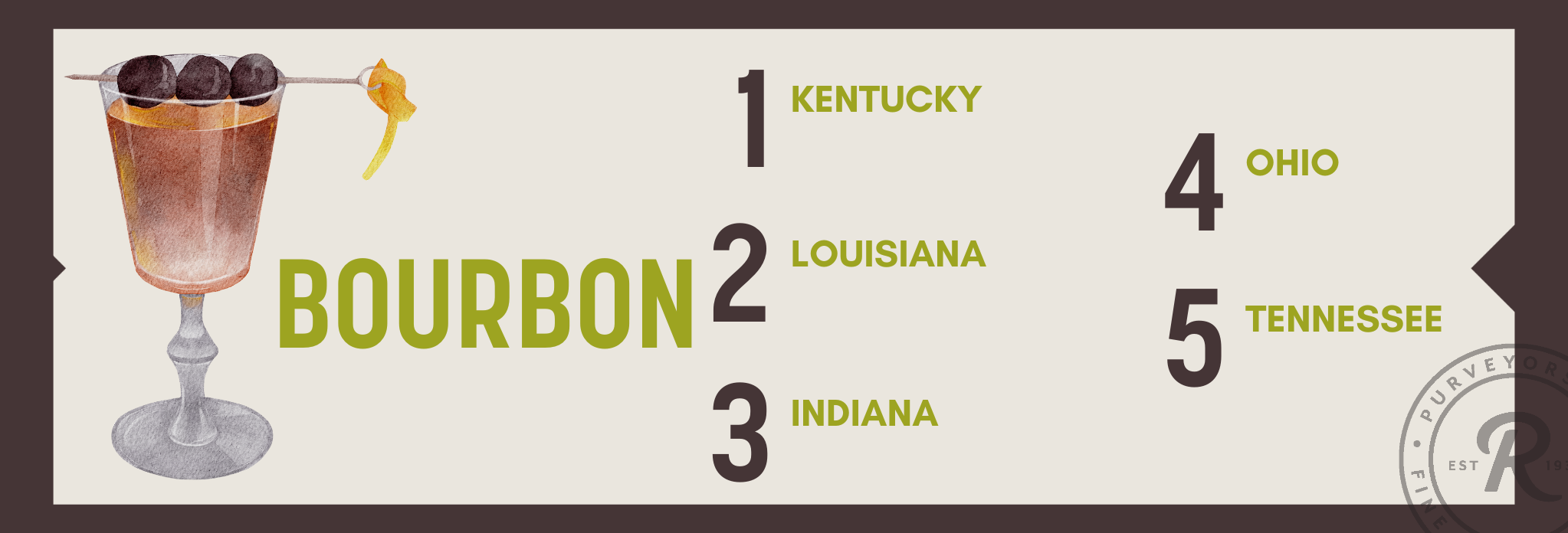
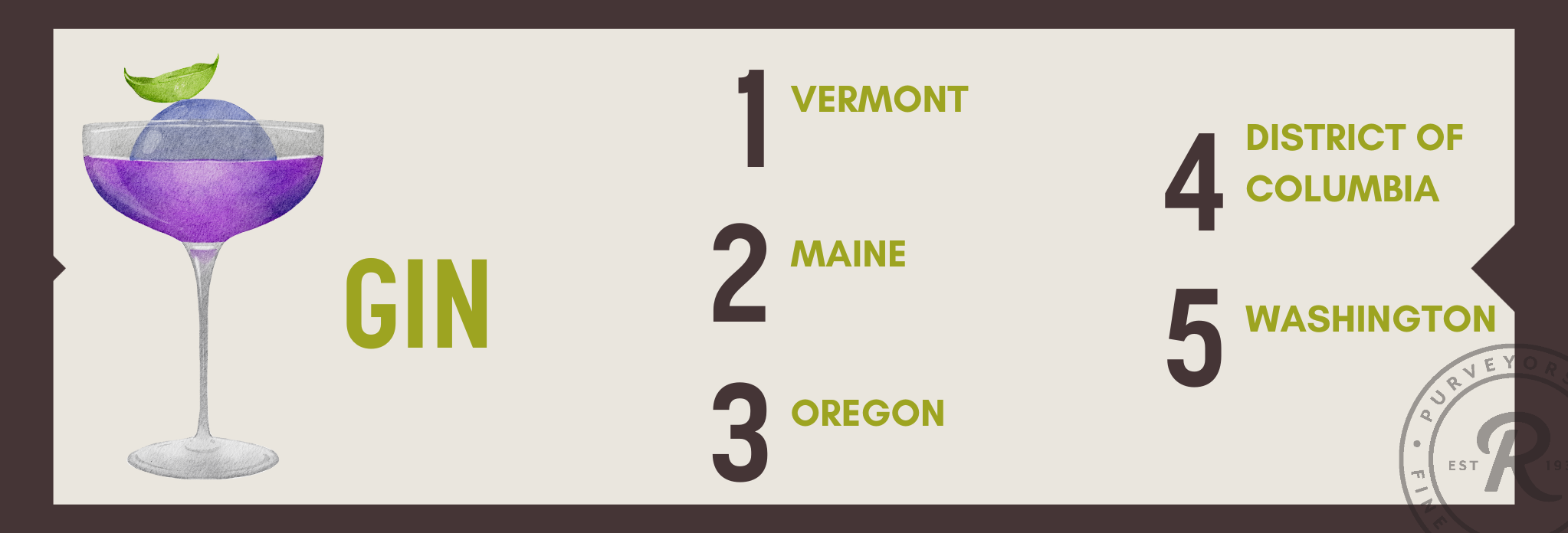
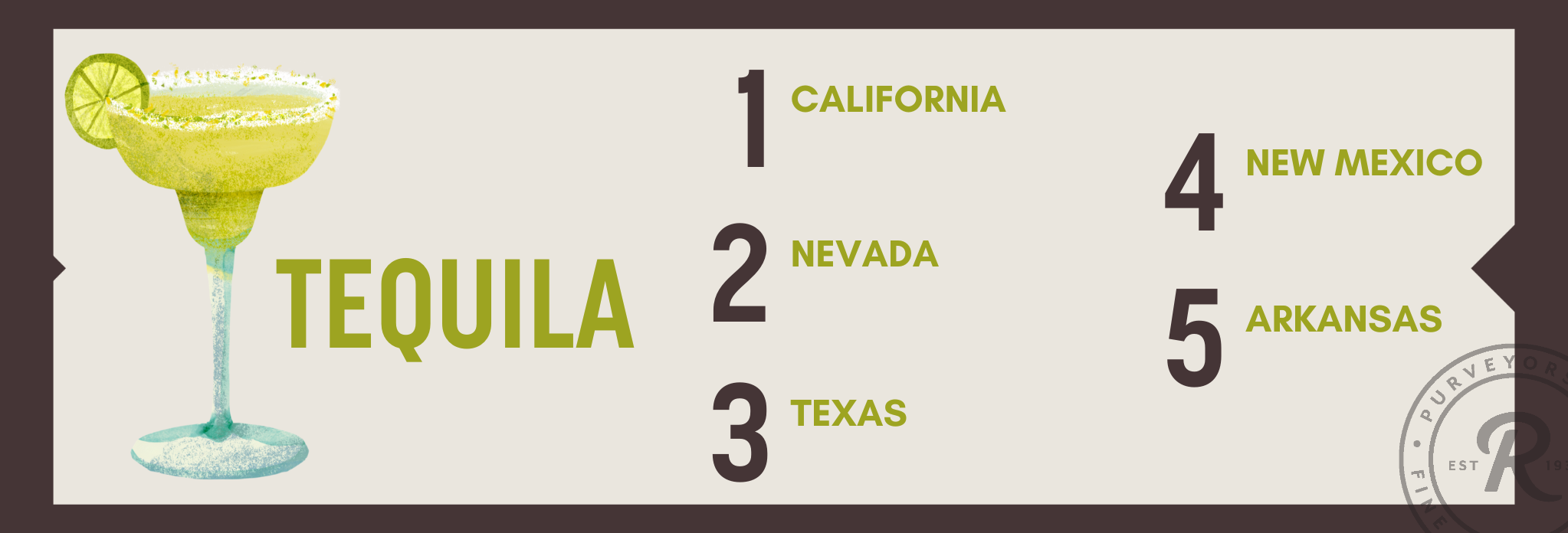
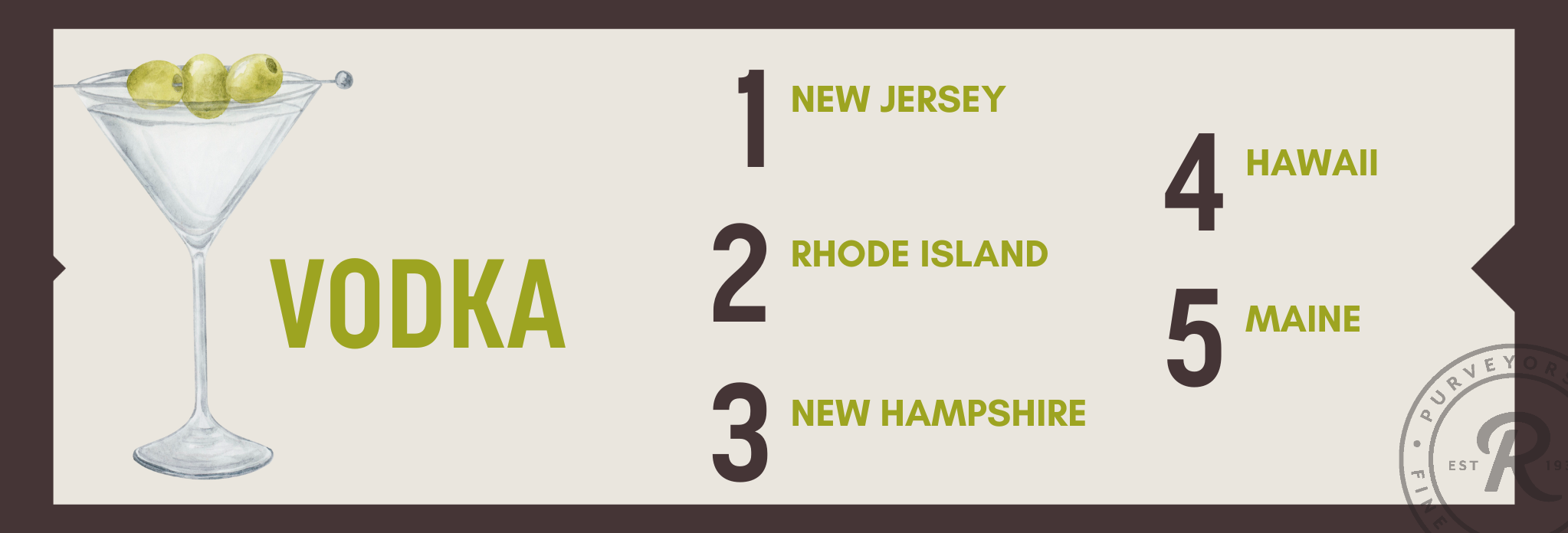
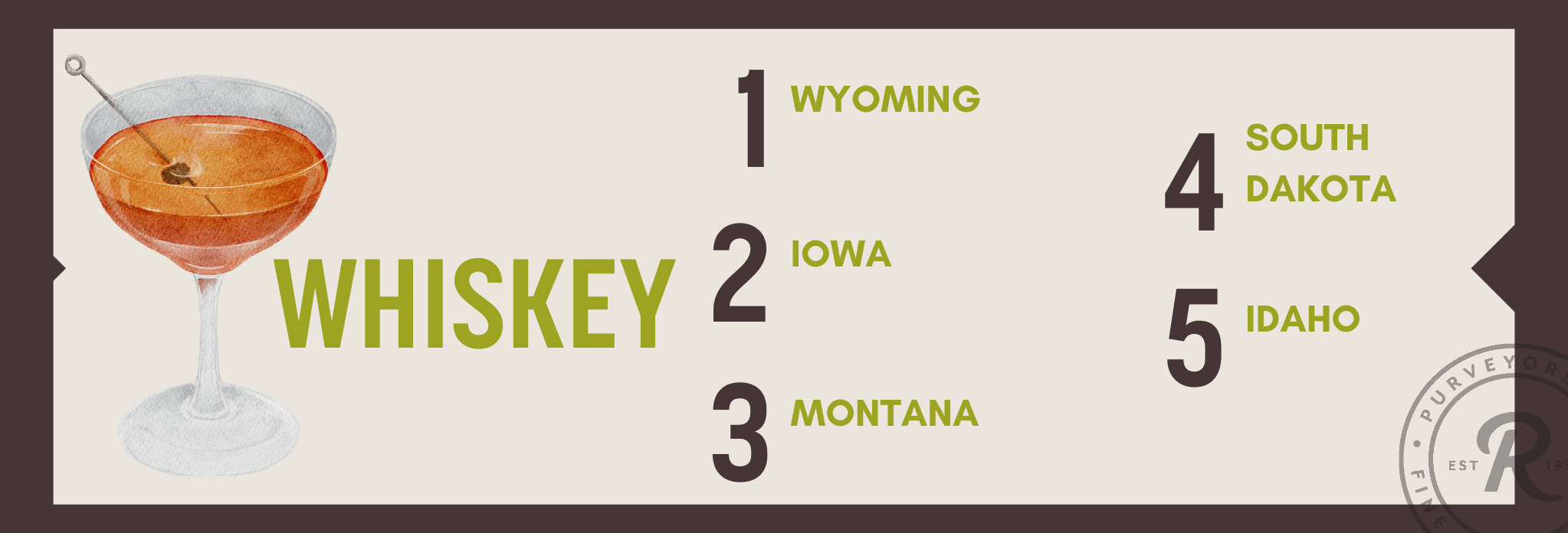
The Perfect Pair: Spirit and Ingredient Selections to Inspire
Ready to shake it up? Check out our ingredient pairing guide to combine spirits and Roland Foods ingredients to inspire new cocktail concepts.
Try Tequila with…
Try Vodka with…
Try Bourbon with…
Try Rum with…
Try Gin with…
Try Whiskey with…
Discover our curated cocktail and mocktail collection!
The Bar Tools You Need to Succeed
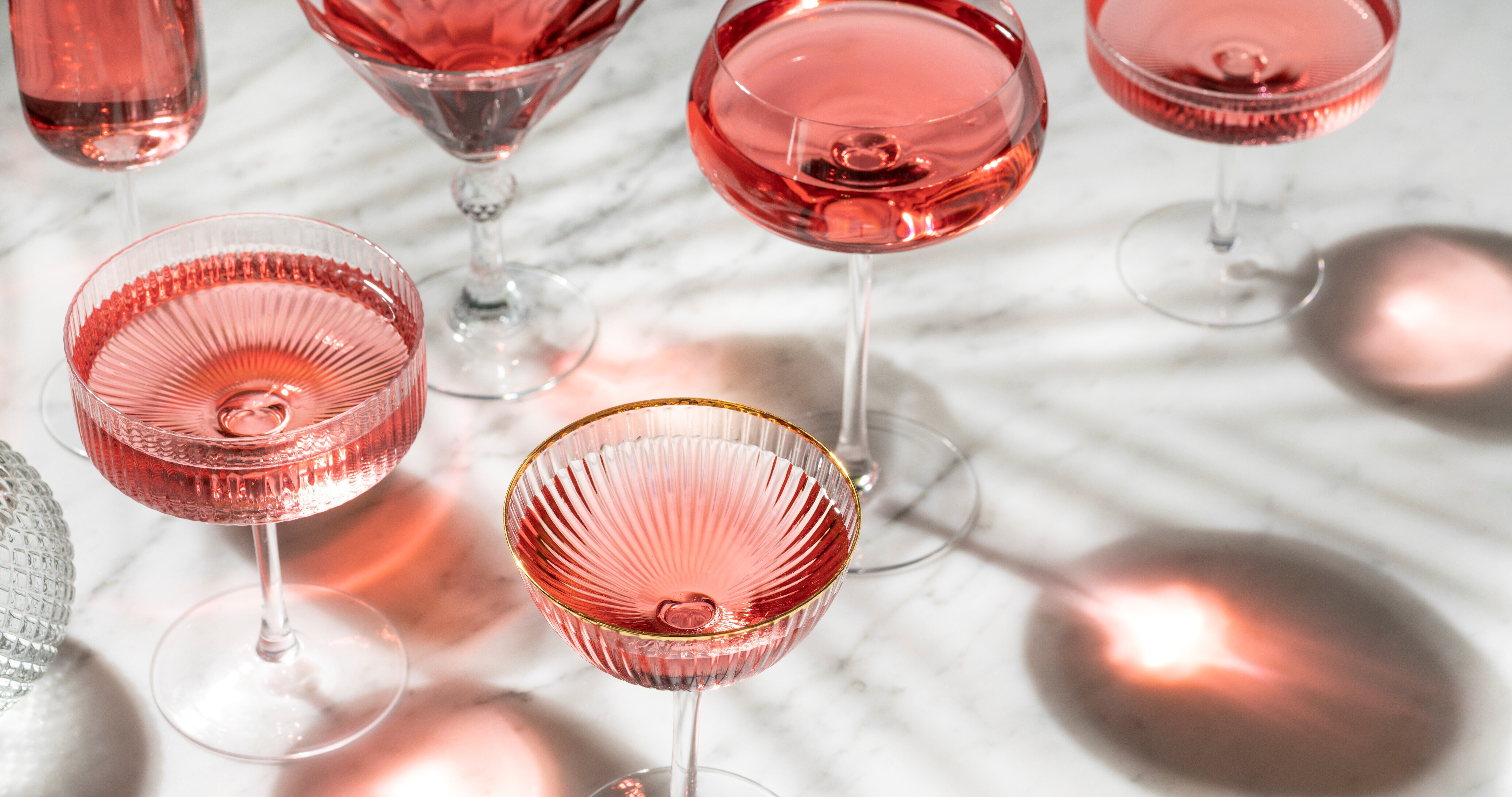
Bringing your cocktail creations to life requires a certain selection of bar tools and glassware. Keep reading to discover our suggested bar necessities.
Glassware 101
Proper glassware is vital for finishing and presenting your cocktail. The shape of glassware dictates the amount and shape of ice, the aroma, and the way the drink is held, all impacting the overall taste of the cocktail. Presentation is everything, so consider glass color and texture as well!
Cocktail Glasses:
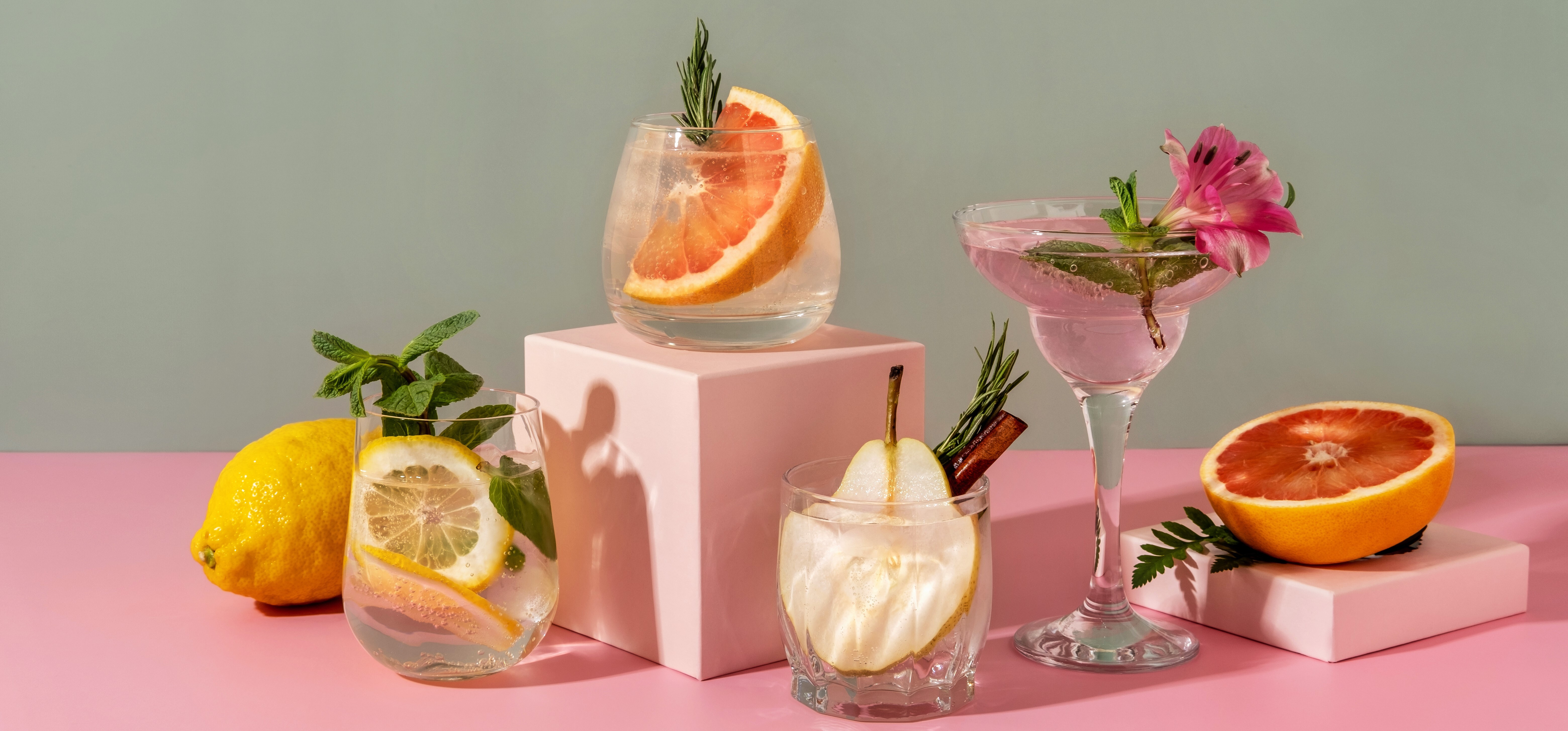
The Martini Glass: One of the most recognizable cocktail glasses known for its unique lifted cone shape. The standard martini glass can hold 3-6-ounce drinks and is meant for beverages served without ice. Its small capacity indicates the type of drink served, which typically is spirit-heavy with few to no mixers. Appropriate cocktails include the classic gin or vodka martini, a Manhattan, or a gimlet. Drinks presented in a martini glass are referred to as “served up.”
Pro tip! Chill your martini glass while you shake or stir your cocktail by filling the glass with ice and water. Simply dump before straining your cocktail in it and present your guest with an ice-cold beverage that will stay chilled longer thanks to the frosted glass.
The Coupe: A relative of the martini glass, the coupe glass is another “up” style cocktail glass that is becoming increasingly popular for its trendy appearance. These glasses were originally designed for champagne, but their wide mouths aren’t particularly suitable for enjoying the sparkling wine. Rather than the cone of a martini glass, a coupe has a wide and shallow cup. Similar to the martini glass, drinks served in a coupe will be chilled but not over ice. The stem of a coupe and martini glass is designed to allow the drinker to hold the cocktail without heating the drink with the warmth of their hands. Common drinks served in a coupe include, but are not limited to, the Lemon Drop, the Aviation, and the Daiquiri.
The Highball and Collins Glass: The Collins Glass gets its name from the famous classic cocktail, the Tom Collins. It is a tall and slim glass that holds around 12 ounces, perfect for mixed drinks, beer, or nonalcoholic drinks. Drinks served in a Collins Glass are both shaken with ice and served over a generous amount of ice in the glass. The highball, often mistaken for the Collins, is slightly slimmer and shorter with a chimney shape. The highball is designed to serve drinks that are half spirit and half mix, with a lot of ice. The chimney shape of the glass also preserves carbonation for a long period of time, making it perfect for drinks like the Gin & Tonic, Vodka Soda, and Rum & Coke.
The Rocks Glass: This low and wide cocktail glass is the quintessential old-fashioned glass, but it has other applications as well. This glass can be found in a single or double serving, with a single holding 6-8 ounces and a double holding 12-14 ounces. This glass is typically used for drinks that are built in the glass rather than in a shaker. The style of the glass makes it perfect for muddling and stirring directly in the glass and looks great when served with a single large ice cube. The purpose of stirring a cocktail directly in the glass with ice is to slightly dilute the alcohol, as these drinks are typically stronger and spirit-forward. Popular cocktails served in a rocks glass include the Old Fashioned, Negroni, Mint Julep, and even a margarita on the rocks.
Snifter: This unique glass was designed for concentrating aromas. It resembles a wide bowl wine glass with a very short stem. The rim of the snifter narrows at the top, allowing the aromas develop at the bottom and gather around your mouth and nose as you sip your drink (hence the name “snifter”). The snifter is typically used for sipping spirits straight, or with no mixer and ice. Common spirits that are enjoyed by a snifter include cognac, brandies, whiskey, and fortified wines.
Beer Glasses:
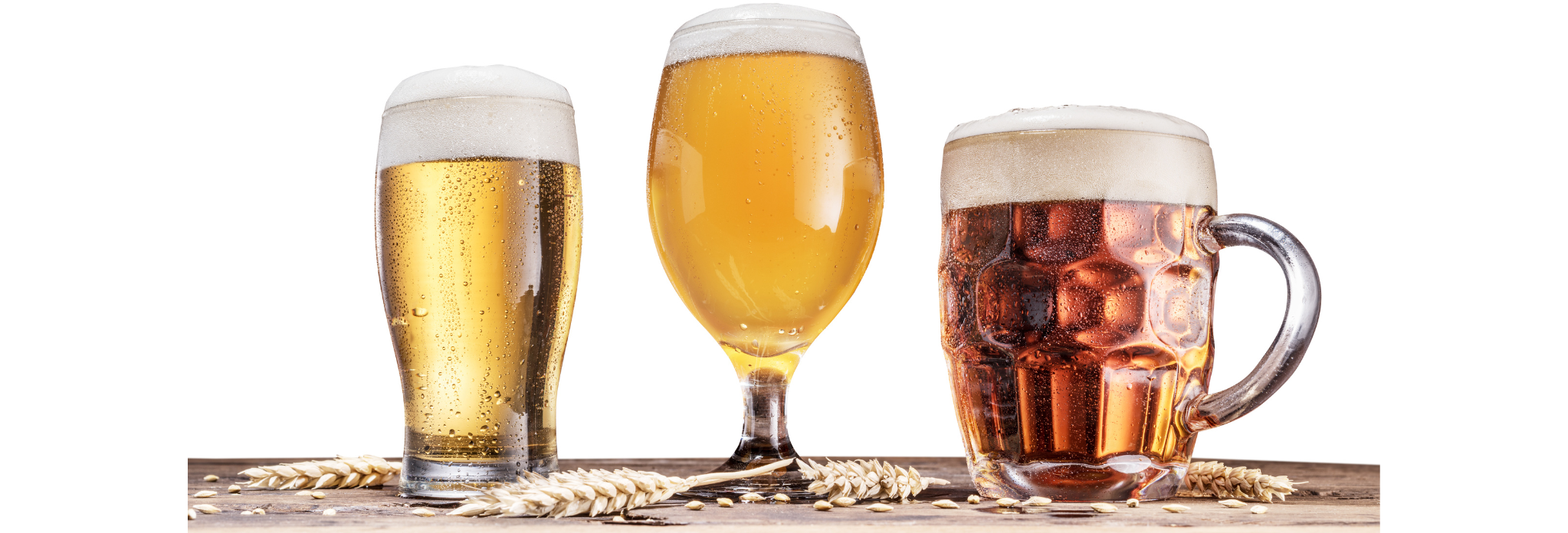
Like cocktails, different types of beers belong in specific glassware.
The Pint Glass: This the classic and most widely used beer glass. The pint glass holds a 16 ounce beverage and maybe be used for serving waters, sodas, and other non alcoholic beverages. This glass is not designed to hold a specific type of beer, but rather act as a simple and easy go-to for bars and restaurants.
The Pilsner Glass: Designed for lighter beers, the pilsner glass is sleek and stylish. This glass is tall and slim, its mouth slightly wider than the base. The pilsner glass is great for locking in aromatics and displaying the beer's clarity.
The Tulip: This stemmed beer glass strongly resembles the snifter cocktail glass. Its wide bowl and tapered lip make it perfect for collecting aromas under your nose. The tulip glass typically serves beers with more hops, like a dark ale or IPA.
The Weizen Glass: Similar in appearance to the pilsner glass, the Weizen is tall and slim, however has more curvature in the body than the pilsner. This specific glass is designed to show off the bright beautiful colors of wheat beers and can hold up to half a liter of beer.
Beer Mugs: A classic of pubs, breweries, and ale houses. Beer mugs can come in different shapes and sizes, but the large handle on the side of the glass is what distinguishes them. The handle of a beer mug is designed with the same purpose of wine and cocktail stems, to keep the beer from getting warm from the heat of your hand. There is not a specific style of beer made to be enjoyed from a beer mug, similar to the pint glass, it is a casual go-to.
Wine Glasses:
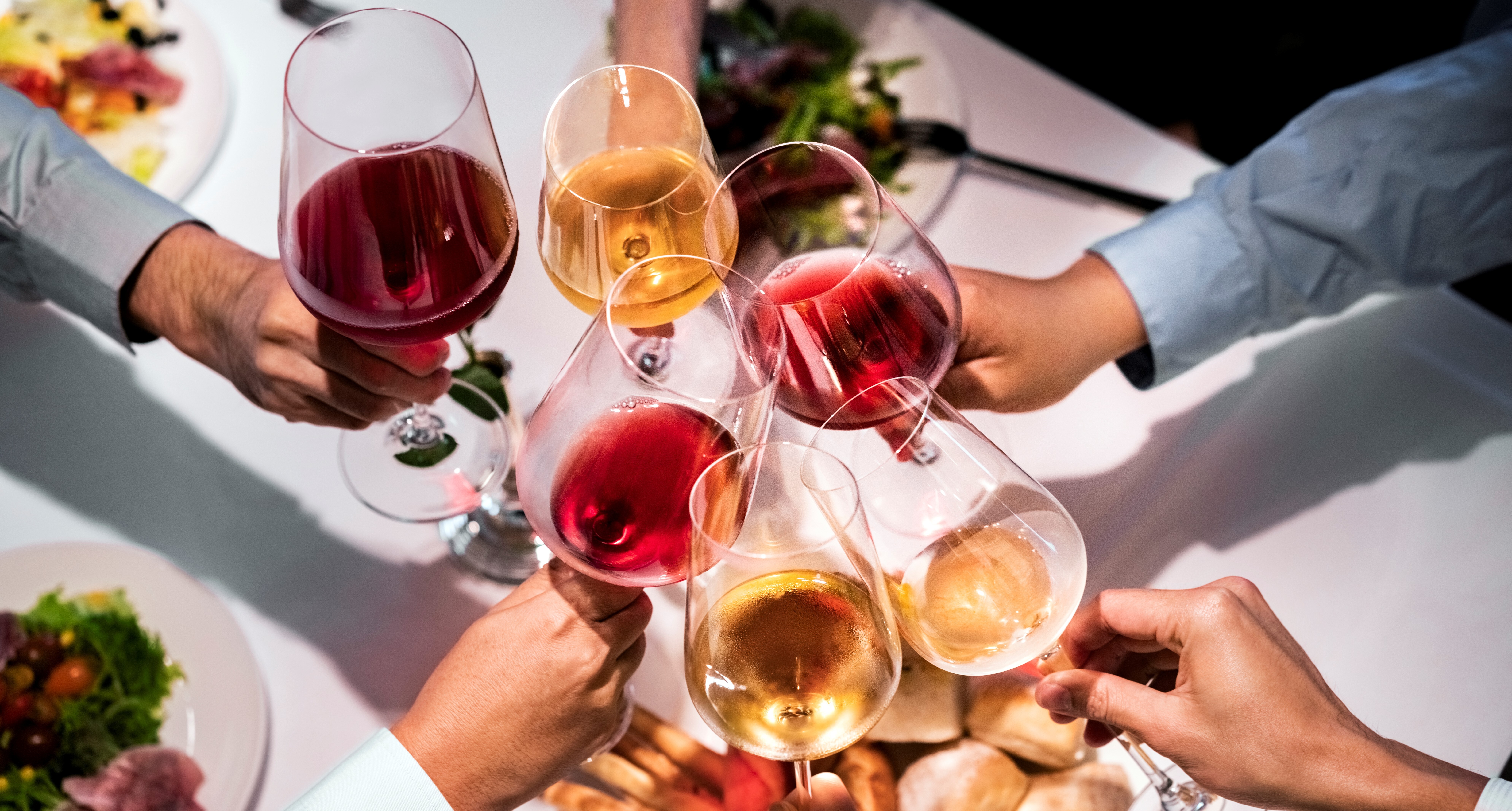
Wine glasses are designed with certain functions in mind, creating the perfect vessel for enjoying each type of wine.
All-round or Universal Wine Glass: To put it in simple terms, the universal or all-round wine glass is designed to complement most types of wine including red and white. While this may not function as the best vessel for some specific types, it is a versatile and reliable option, great for enjoying wine at home.
The Bordeaux Glass: This glass is designed to hold heavy and full-bodied red wines. The Bordeaux features a smaller bowl with taller walls to maximize flavor. Cabernet Sauvignon, Cabernet Franc, Syrah, Merlot, and Malbec can all be enjoyed from a Bordeaux.
The Burgundy Glass: The Burgundy glass features a wide bowl and slightly smaller stem, and it designed for enjoying lighter, but still full-bodied, red wines. The large bowl directs the wine to the tip of the tongue to emphasize more delicate flavors. Perfect pairings for a Burgundy glass include Pinot Noir, Barbaresco, Barolo, Barbera, and Red Burgundy.
The Chardonnay Glass: Despite its name, this glass can be used for drinking many types of white wine, not only chardonnay. The chardonnay glass is designed with a larger bowl, making it perfect for enjoying both the flavor of full-bodied white wines and aromas of oak-aged white wines.
Light Bodied White Wine Glass: This glass is designed specifically for more delicate white wines. The small bowl and tapered mouth are perfect for preserving floral aromas and maintaining cooler temperature (as white wines are typically served slightly chilled). Riesling, Sauvignon Blanc, and Pinot Grigio can all be enjoyed from this style glass.
A Bartender’s Toolkit
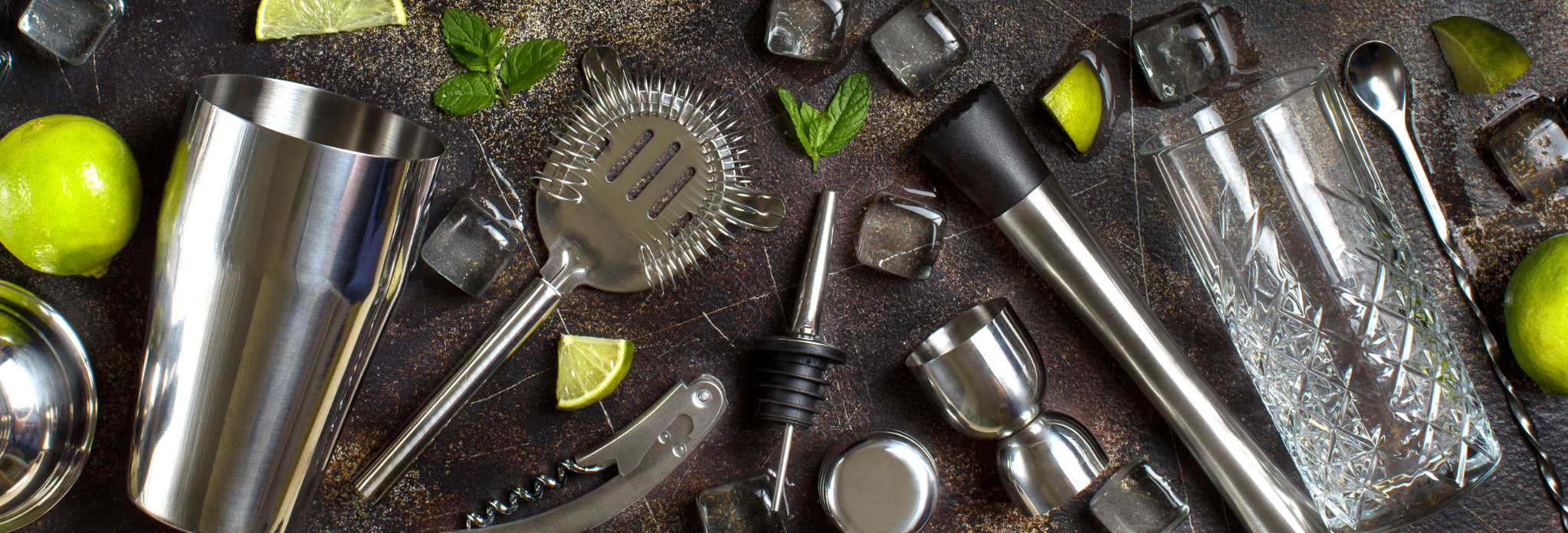
A bartender, like any craftsperson, needs a proper toolkit. Keep reading to learn about all the tools needed behind the bar to craft the perfect cocktail.
Cocktail Shakers: Cocktail shakers are vital to a bar and come in a few shapes and styles. The Boston shaker is a favorite among professional bartenders. This style features two tins, one slightly larger than the other. Bartenders will pour the ingredients into one side of the shaker, add ice, close the other tin on top, and start shaking! The purpose of shaking a cocktail in tin cups is to mix, aerate, and chill the drink; shaking with ice also slightly dilutes the cocktail. Other cocktail shaker styles include the Cobbler and the Parisian, more suitable for at-home experimentation.
Cocktail Strainers: Similar to cocktail shakers, strainers also come in a variety of styles. The three major strainers that every bar should have are the Hawthorne, Julep, and Fine Mesh strainer. Each strainer serves a different purpose: the Hawthorne is the most widely used, and its design fits perfectly over a Boston shaker. The Julep strainer, which resembles a slotted spoon, is typically only used for straining stirred drinks with no solids. The Fine Mesh strainer is the most effective strainer and is often used in tandem with the Hawthorne to “double strain” drinks like martinis.
Jiggers: Jiggers, a bartender’s measuring cups, are typically made of stainless steel and double-sided for convenience and efficiency. The standard jigger is 1 ounce on one side and 2 ounces on the other, but there are many variations that offer alternative measurements. The jigger is not only used for spirits, but also used to measure mixers like juices and liqueurs.
Bar Spoons: Bar spoons are the mixing agents for non-shaken cocktails. These spoons are very long with a twisted stem, designed to spin between a bartender’s fingers for a well-stirred beverage. The twisted stem also aids in pouring alcohol to create drinks or shots with a layered effect. Bar spoons also come with a variety of ends: some have a flat top to act as a muddler, while some feature a weighted teardrop designed for comfort.
A Snack Menu, Too
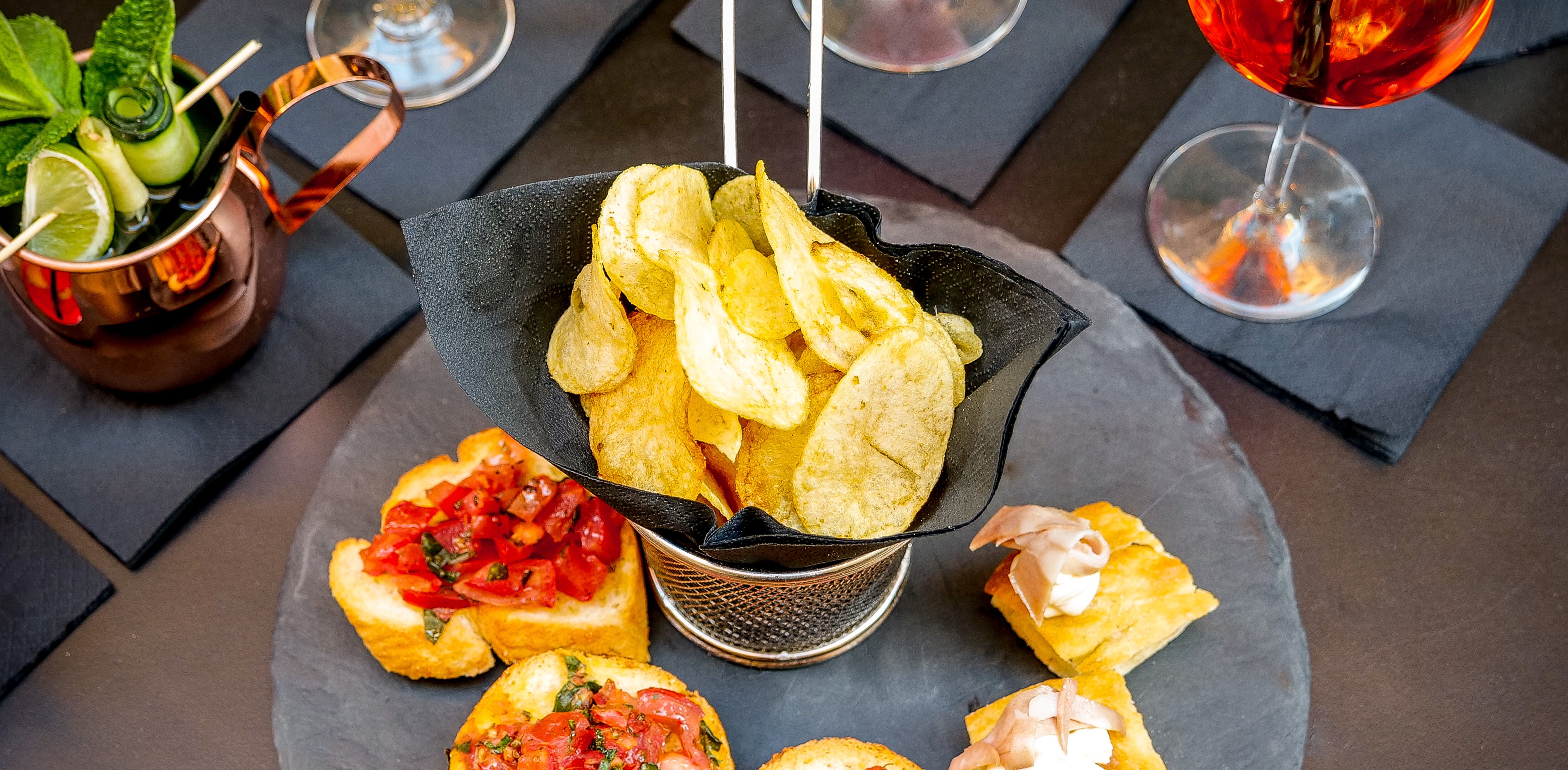
Consider adding a refined menu of bar snacks to pair with your drink list. Choosing items that complement the flavor and style of your cocktails is key! Think of these snacks as a preview to your menu, so take this chance to hook your bar guests into staying for dinner service.
Bar snacks have been around for ages, and classics include salted nuts, chips, and popcorn. These savory snacks were originally served because the salt made beer taste smoother, plus they made drinkers thirsty for more!
Try incorporating small bites that pair well with drinks on your menu and are easy to share. Oysters are a great up-scale snack option that pairs well with many white wines and gin martinis.
Experiment with sweet and spicy. A sweet and fruity cocktail or a light and fresh wine pair great with a spicy snack like hot wings! Citrus forward drinks also complement spicy food, as they offer some relief to the palate. Try pairing a gimlet or a lemon drop with charred peppers and spicy dipping sauces.
Looking for a quick fix to bring some heat to your menu? Check out our Spicy Chili Onion Crisp, perfect for marinades, wings, or dipping!
A fun way for high-end cocktail bars to join in on bar snacks is creating elevated spins on classic bar foods. Check out how swanky NYC cocktail lounge, Nubeluz, offers a grilled cheese (with optional truffles!) for snacking.
Charcuterie boards are also perfect options for any cocktail bar. These delicious, customizable spreads are perfect for grazing and sharing.
Chef Tip: Go beyond the classic meat and cheese board and get creative! Experiment with hummus grazing boards, pickled boards, or even a dessert board!
Check out how we designed a variety of grazing boards:
- Classic Charcuterie Board
- Fig Jam Brie Wheel (Charcuterie Board)
- Hummus Grazing Board
- Cookie Butter & Fig Jam Dessert Board
Irresistible Offers
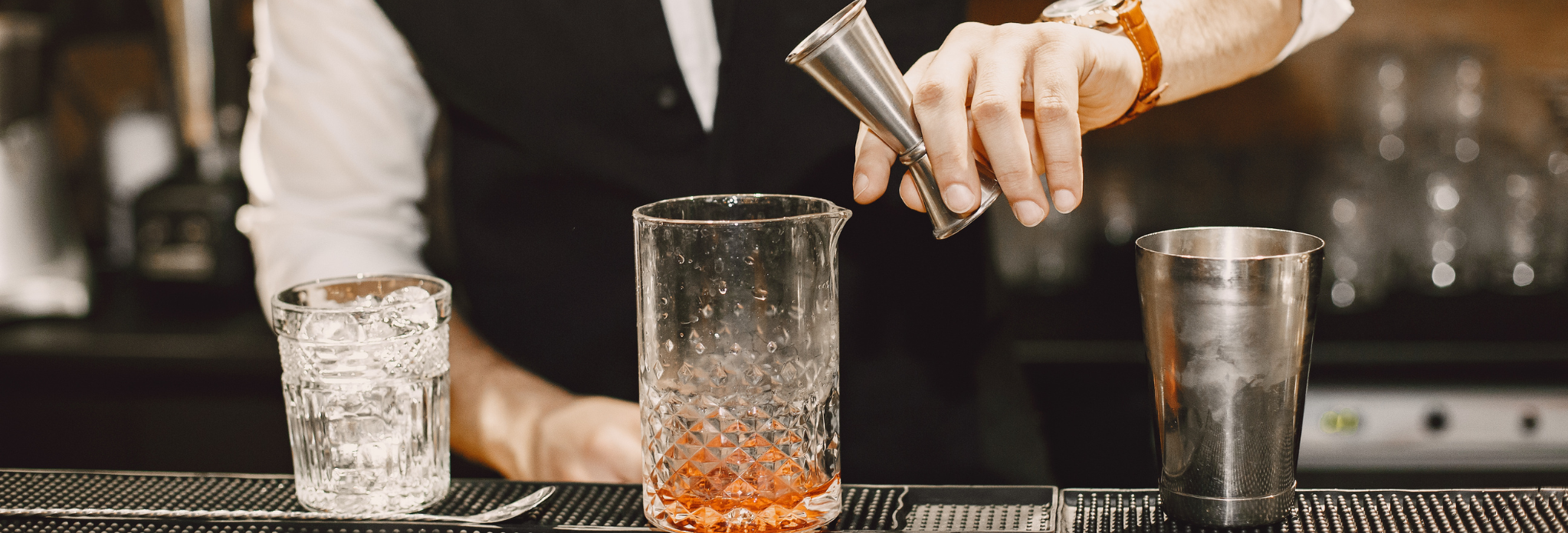
Incorporate “happy hours” into your bar program to drive foot traffic, especially on off-peak days and times. Offering beverage discounts or combined food and beverage deals entice passers-by to visit your establishment, and often result in higher tickets. A study by Nielsen concluded that the average happy hour check was more expensive than the average check during regular sale hours.
As discussed in our 2023 Fine Foods Industry Trend and Predictions Guide, customer loyalty programs are booming. Creating consistent happy hours each week has the potential to attract new customers and return repeat customers. To fill your seats, try offering happy hour loyalty programs, such as punch cards for a free drink.
Italian-Style
The Italian custom of “aperitivo” is another happy hour approach to drive food and beverage sales. Aperitivo is a pre-dinner drink that is designed to whet your appetite, and is often associated with certain types of liqueurs, like Campari or Aperol. Aperitivo drinks are often light on alcohol and slightly bitter, which means they pair perfectly with salty snacks, too. Try adding an Aperol or Campari Spritz to your happy hour menu for a refreshing offering that excites your guests for a full meal.
Did you know? The Aperol Spritz was the drink of the summer in 2022. Check out how search volume for Aperol Spritz spiked during the summer months!
It doesn’t end at an Aperol Spritz. Classics like Gin or Vodka Martini, Negroni, and Negroni Sbagliato all contain spirits that have the aperitivo characteristic!
Aperitivo Spirits
- Vermouth
- Campari
- Aperol
- Amaro
Roland Foods’ Spin on Classic Cocktails
Now that you’re an expert in building a bar program, we’d like to share our latest creations! Inspired by classic cocktails, we’ve curated three modern beverages that are sure to stand out on your cocktail list.
"East Side" Manhattan: The Manhattan is a timeless cocktail, and at one point was even the most famous cocktail in world! The drink got its name from New York City’s Manhattan Club, where it originated. Typically, the Manhattan is comprised of whiskey, sweet vermouth and angostura bitters, garnished with maraschino cherries. Roland Foods’ twist on the Manhattan involves fat-washing Whiskey using our Roland® Toasted Sesame Oil , and brining Roland® Amarena Cherries in our Roland® White Miso Paste for a globally evocative cocktail.
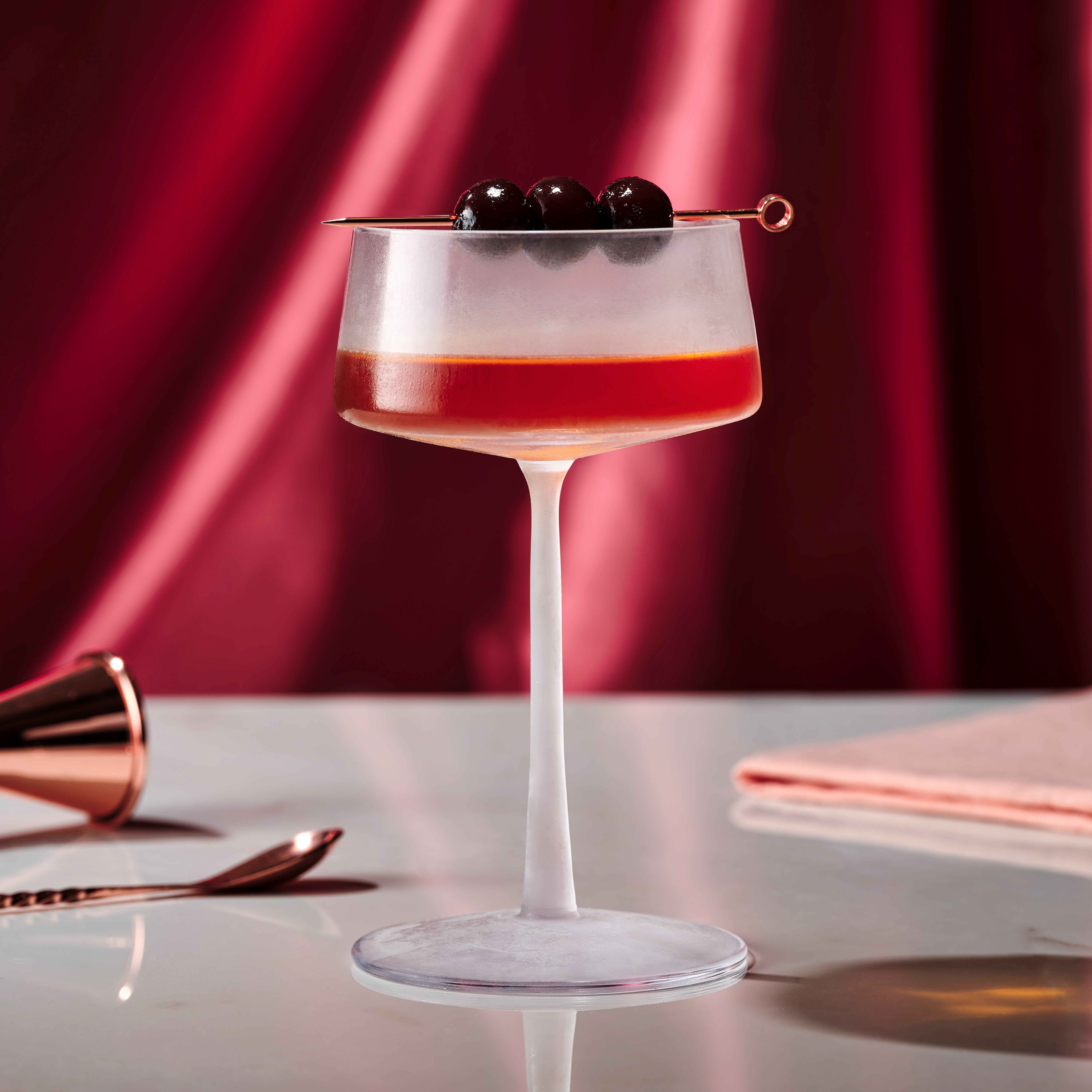
"For the Love of Brine" Martini: Another legendary cocktail is the Dirty Martini, known for being strong and salty! Dirty Martinis and Martinis in general are curious cocktails, as most drinkers have a unique preference of how they like their Martini made. Gin or vodka? Dry or wet? Shaken or stirred? Twist or olive? The classic Dirty Martini uses olive juice, but our Roland Foods’ spin uses the brine of our Roland® Wild Caperberries and Roland® Olive Juice. To add an extra kick to this cocktail, we infused gin with Roland® Green Peppercorns to give the spirit an added pepper flavor and a slight green hue. A Dirty Martini wouldn’t be complete without a garnish; but instead of using olives, we topped ours with whole skewered caperberries for a modern look!
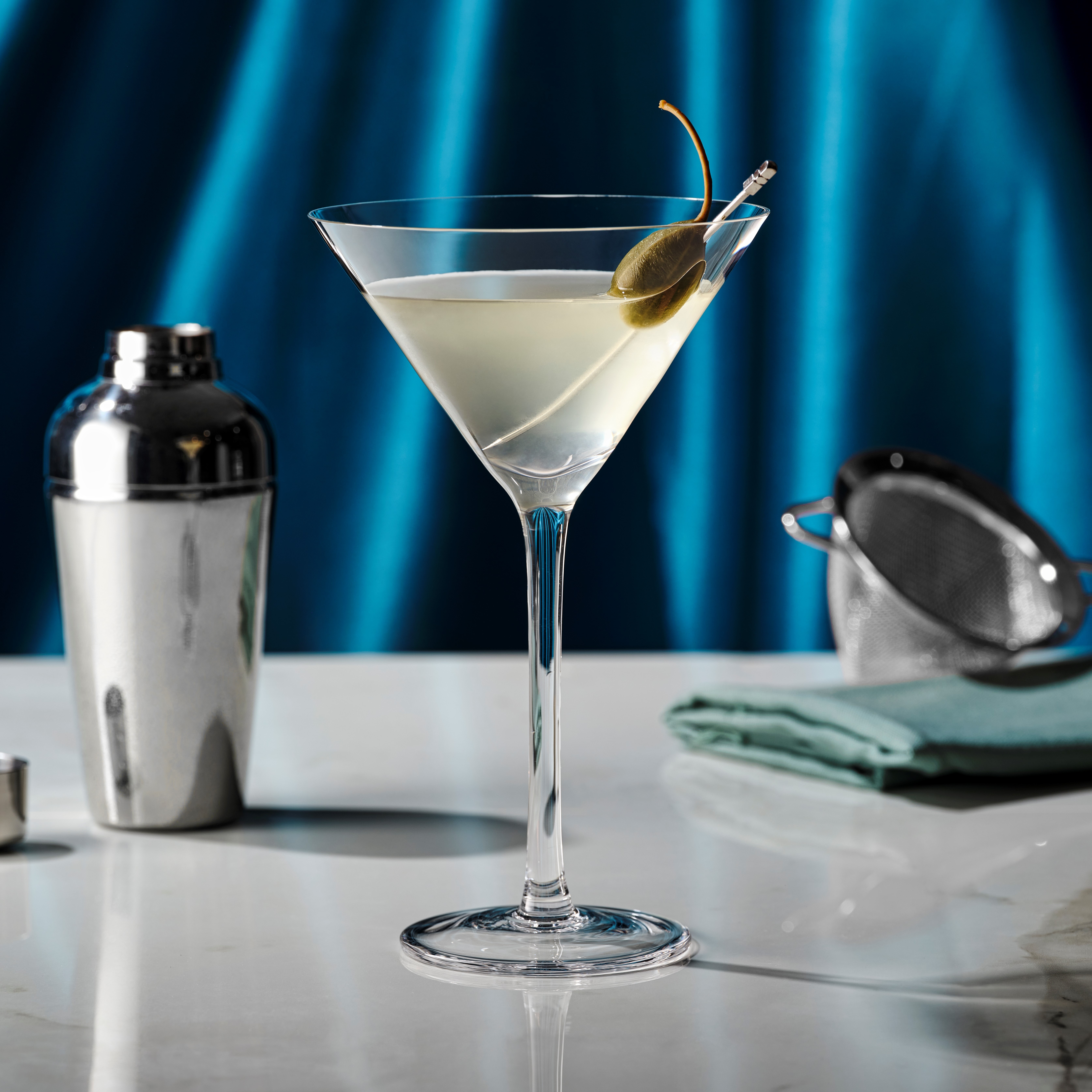
"This is my Jam" Negroni: This classic Italian cocktail has become a menu staple in bars around the world. Originating in Florence, Italy in 1919, this drink has since been adapted many times over, resulting in variations like the Negroni Sbagliato. The Negroni has a very intense flavor, which comes from the bitter Italian liqueur, Campari. Our version is slightly sweeter, making the cocktail a bit more balanced and approachable. Our Fig and Ginger Negroni follows the classic negroni recipe, with the addition of our Roland® Fig Jam, and an upgraded garnish of Roland® Sliced Crystallized Ginger instead of the classic orange twist.
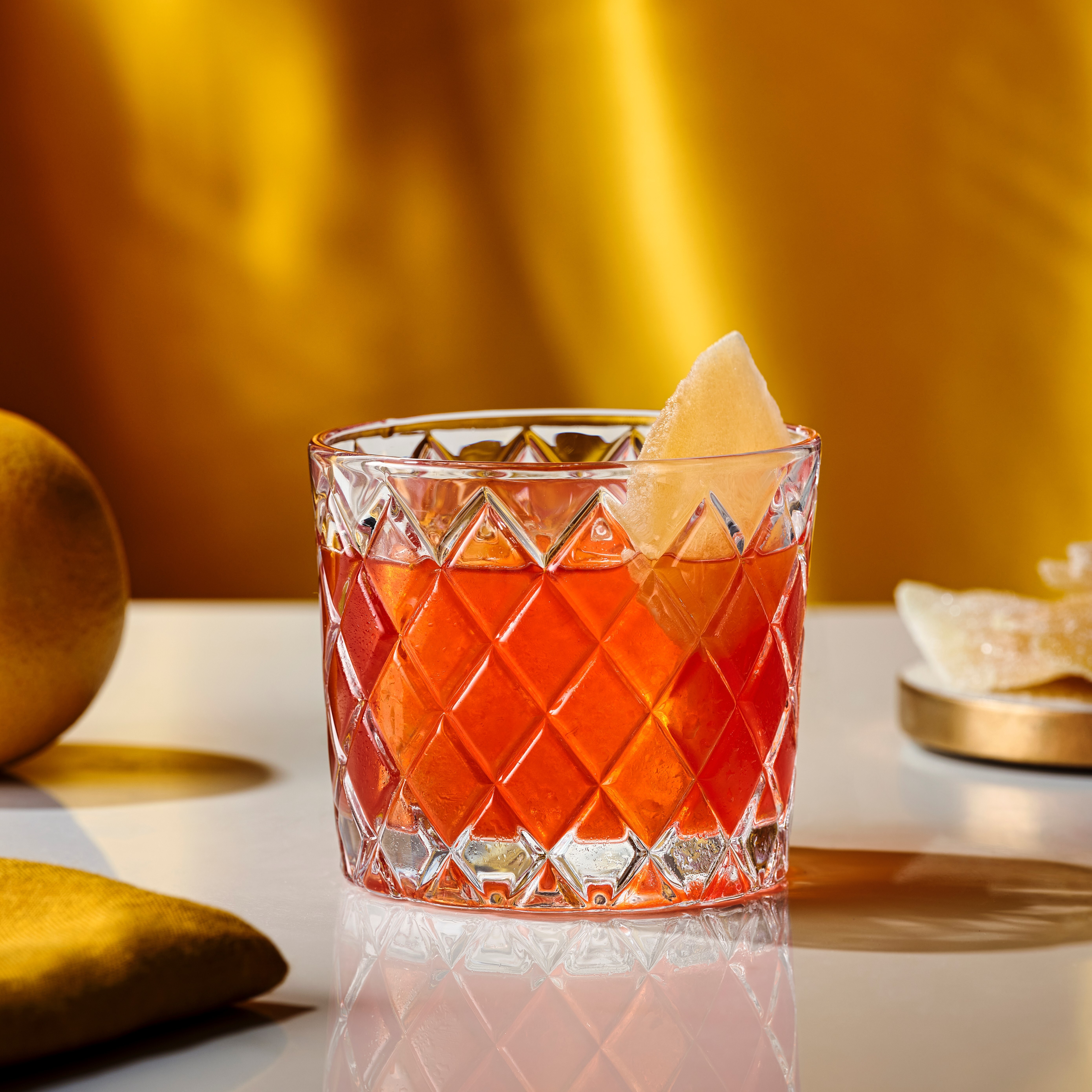
Its Time to Get Shakin’
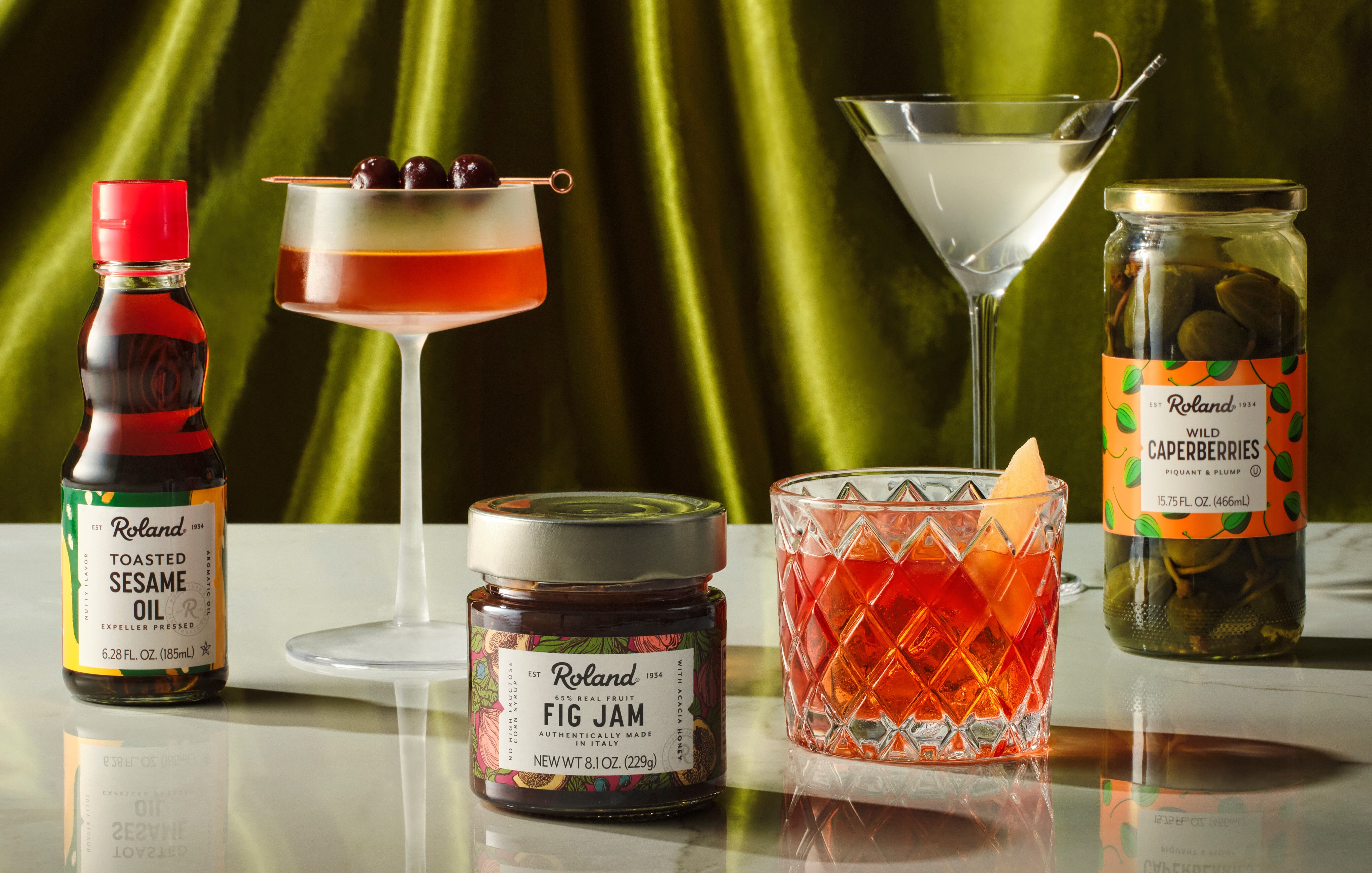
At Roland Foods, we are excited for the new wave of creative cocktail lounges and bars. With so much room for creativity and innovation, we cannot wait to see bartenders’ and mixologists’ newest creations. A successful bar program, if done right, can help boost consumer interest and profits at your establishment.
As a purveyor of fine ingredients, Roland Foods is proud to offer a wide array of globally sourced products perfect for garnishing, shaking, or stirring into creative beverages. For more inspiration, check out our comprehensive list of Bar & Cocktail Items here and our interactive flipbook all about cocktails here.
Related Products
Recommended Reads
February 20, 2024 | Food Trends Foodservice Guides
What is an LTO? Leveraging Limited Time Offers in Foodservice
What is an LTO? Limited Time Offers are a valuable tactic used widely across the foodservice landscape to boost sales and drive foot traffic. Learn more about the different types of LTOs, marketing strategies, and how Roland® can be your LTO partner in our comprehensive guide.
December 29, 2023
Cooking Oil Alternatives | Expand Your Pantry with Roland Foods
Navigating the Olive Oil shortage with Roland Foods. Expand your pantry with alternative cooking oils and custom blends.
November 13, 2023 | Food Trends
Roland Foods' 2024 Fine Foods Industry Trends & Predictions Guide
The Roland Foods' 2024 Fine Foods Industry Trends & Predictions Guide gives insights into trending global flavors, ingredients, and dining habits for 2024. Discover our predictions for the biggest food trends this year!
